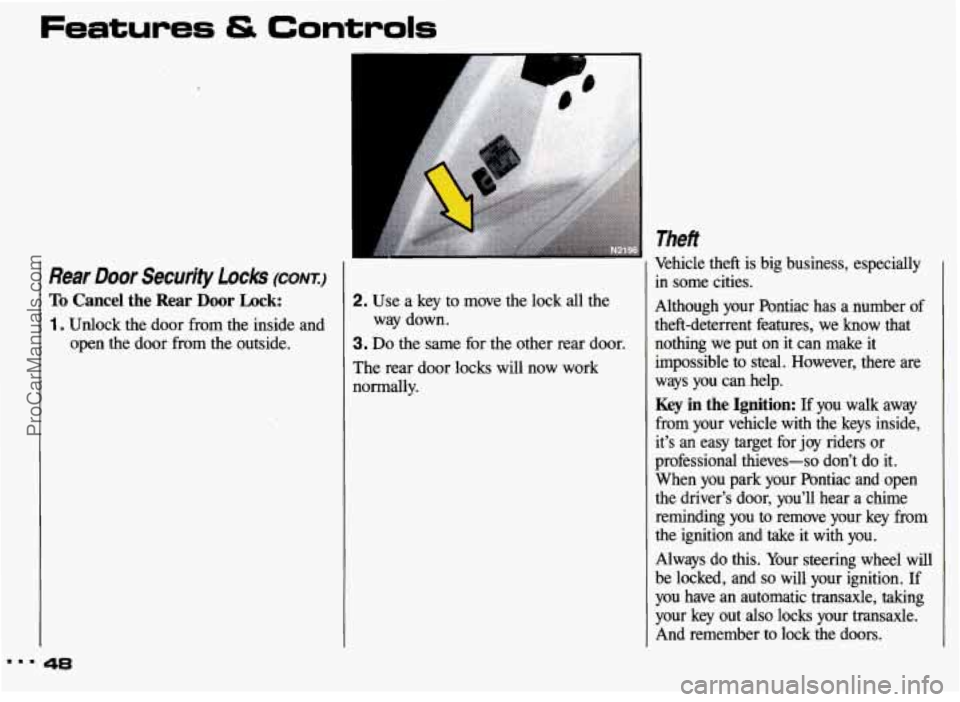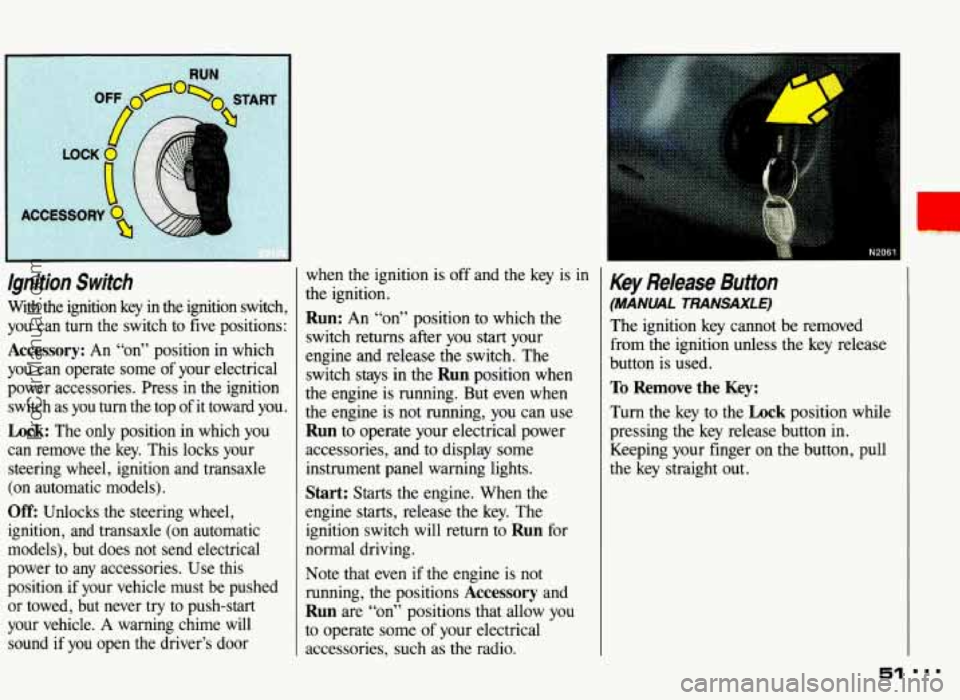1993 PONTIAC GRAND-AM ignition
[x] Cancel search: ignitionPage 44 of 306

Here you can learn about the
many standard and optional features
on your Pontiac. and information on
starting. shifting and braking
. Also
explained are the instrument panel
and the warning systems that tell
you
if everything is working
properly-and what to do
if you have
a problem
.
Part 2
Features & Controls
Keys .............................. ............................ 44
GloveBox ....................................................... 50
StartingYourEngine
............................................... 52
LOC
ks ........................................................... 45
Ignitionswitch
.................................................... 51
Engine Block Heater
............................................... 56
Shifting the Transaxle
.............................................. 57
ShiftingIntoPark
.................................................. 64
Turn SignaVHeadlight Beam Lever .................................... 69
Cruisecontrol .................................................... 70
Lightcontrols
.................................................... 74
Interior Lights
.................................................... 76
Windshield Wipers
................................................. 79
Windshield Washer ................................................ 80
Mirrors .......................................................... 81
Ashtray and Lighter ................................................ 85
Warning Lights, Gages and Indicators .................................. 91
ParkingBrake
.................................................... 63
Windows
........................................................ 68
Sunvisors
....................................................... 82
InstrumentPanel
.................................................. 86
ProCarManuals.com
Page 45 of 306

Features & Controls
Keys
P
.~eaving young children in a‘
vehicle with the ignition key
is dangerous for many reasons. A
child or others could be badly
injured. or even killed.
They could operate power
windows or other controls or even
make the vehicle move.
Don’t leave the keys in a vehicle
with young children. The
ignition keys are for the ignition
only.
The door keys are for the doors and all
other locks. {hen
a new Pontiac is delivered, the
:aler removes the plugs from the keys,
Id gives them to the first owner.
ach plug has a code on it that tells your
:aler or a qualified locksmith how to
lake extra keys. Keep the plugs in a
lfe place.
If you lose your keys, you’ll
; able to have new ones made easily
sing these plugs.
... 44
ProCarManuals.com
Page 47 of 306

Features & Controls
Power Door Locks
With power door locks, you can lock or
unlock all the doors of your vehicle
from the driver or front passenger door
lock switch.
On 4-door models, the mechanical
switch on each rear door works only
that door’s lock. It won’t lock (or
unlock) all of the doors-that’s a safety
feature.
Automatic Door Locks
Just close your doors and turn on the
ignition. If you have an automatic
transaxle, all of the doors will lock
when
you move your shift lever out of
P (Park) or N (Neutral). If you have a
manual transaxle, all of the doors will
lock when the vehicle reaches about
8 mph (13 km/h). Each time you close
your doors and
turn on the ignition, the
doors will lock automatically only once.
If someone needs to get out while the
vehicle is running, have that person use
the manual or power lock. When the
door is closed again, it will not lock
automatically. Just use the manual or
power lock to lock the door again.
Leaving Your Vehicle
If you are leaving the vehicle, open your
door and set the locks from inside, then
get out and close the door.
Illuminated Entry/Exit System
When you lift the outside handle of either front door, the lights inside your
vehicle will go on. These lights will go
off after about
40 seconds, or when the
ignition is turned on.
If the ignition has been off for less than
two minutes, the lights inside your
vehicle will stay on for about four
seconds to provide
an illuminated exit.
ProCarManuals.com
Page 49 of 306

Features & Controls
‘1
Rear Door Security Locks (CONT.)
To Cancel the Rear Door Lock:
1 . Unlock the door from the inside and open the door from the outside.
48
2. Use a key to move the lock all the
3. Do the same for the other rear door.
The rear door locks will now work
normally. way
down.
Theft
Vehicle theft is big business, especially
in some cities.
Although your Pontiac has a number of
theft-deterrent features, we know that nothing we put on it can make it
impossible
to steal. However, there are
ways you can help.
Key in the Ignition: If you walk away
from your vehicle with the keys inside,
it’s an easy target for
joy riders or
professional thieves-so don’t do it.
When you park your Pontiac and open
the driver’s door, you’ll hear a chime
reminding you to remove your key from
the ignition and take it with you.
Always do
this. Your steering wheel will
be locked, and
so will your ignition. If
you have an automatic transaxle, taking
your key out
also locks your transaxle.
And remember to lock the doors.
ProCarManuals.com
Page 50 of 306

Parking at Night: Park in a lighted
spot, close all windows and lock your
vehicle. Remember to keep your valuables out of sight. Put them in a
storage area, or take them with you.
Parking Lots: If you park in a lot where
someone will be watching your vehicle,
it’s best to lock it up and take your keys.
But what if you have to leave your
ignition key? What if you have to leave something valuable in your vehicle?
Put your valuables in a storage area,
Activate the remote trunk release
Lock the glove box.
Lock all the doors except the driver’s.
Then take the door key with you.
like your trunk
or glove
box.
lockout feature.
Trunk Lock
To unlock the trunk from the outside,
insert the door key and
turn the trunk
lock cylinder.
Remote Trunk Release
Pull upward on the remote release
handle, located on the floor near the left
side of the driver’s seat, to release the
trunk lid. Make sure the lockout feature
is not activated.
ProCarManuals.com
Page 52 of 306

lgnition Switch
With the ignition key in the ignition switch,
you can turn the switch
to five positions:
Accessory: An “~n” position in which
you can operate some of your electrical
power accessories. Press in the ignition
switch as you turn the top of it toward you.
Lock: The only position in which you
can remove the key. This locks your
steering wheel, ignition and transaxle
(on automatic models).
Off: Unlocks the steering wheel,
ignition, and transaxle (on automatic
models), but does not send electrical
power to any accessories. Use this
position if your vehicle must be pushed
or towed, but never try to push-start
your vehicle.
A warning chime will
sound if
you open the driver’s door when
the ignition is
off and the key is in
the ignition.
Run: An “on” position to which the
switch returns after you
start your
engine and release the switch. The
switch stays in the
Run position when
the engine is running. But even when
the engine is not running,
you can use
Run to operate your electrical power
accessories, and
to display some
instrument panel warning lights.
Start: Starts the engine. When the
engine starts, release the key. The
ignition switch will return to
Run for
normal driving.
Note that even if the engine is not
running, the positions
Accessory and
Run are “on” positions that allow you
to operate some of your electrical
accessories, such
as the radio.
Key Release Button
(MANML TRANSAXLE)
The ignition key cannot be removed
from the ignition unless the key release
button is used.
To Remove the Key:
Turn the key to the Lock position while
pressing the key release button in.
Keeping your finger on the button, pull
the key straight out.
51 ...
ProCarManuals.com
Page 54 of 306

Automatic Tmnsaxle
Move your shift lever to P (Park) or
N (Neutral). Your engine won’t start in
any other position-that’s a safety
feature.
To restart when you’re already
moving, use
N (Neutral) only.
Don’t
try to shift to P (Park) if
5 your Pontiac is moving. If you do,
! you could damage the transaxle.
3 Shift to P (Park) only when your
vehicle is stopped.
8‘
Manual Tmnsaxle
Shift your gear selector to N (Neutral)
and hold the clutch pedal to the floor
while starting the engine. Your vehicle
won’t start
if the clutch pedal is not all
the way down-that’s a safety feature.
Both Tmnsax/es
To Start Your 2.3L Quad OHC or
Quad
4 Engine (Code 3, A or D):
1 , Don’t push the accelerator pedal
before starting your engine. In some
other vehicles you might need to do
this, but because of your vehicle’s
computer systems, you don’t.
2. Turn your ignition key to Start.
When the engine starts, let go of the
key. The idle speed will go down as
your engine gets warm.
3. If it doesn’t start right away, and the
weather is very cold (below
-20°F’ or
-29”C), push the accelerator pedal
about one-quarter of the way down
while you turn the key to
Start. Do
this until the engine starts. As soon as
it does, let go
of the key.
53
ProCarManuals.com
Page 55 of 306

Features & Controls
Both Transax/es (CONTI
Holding your key in Start for
longer than
15 seconds at a time
will cause your battery
to be
drained much sooner. And the
excessive heat can damage your
starter motor.
4. If your engine still won’t start (or
starts but then stops), it could be
flooded with too much gasoline.
Try
pushing your accelerator pedal all tht
way to the floor and holding it there
as you hold the key in
Start for abou
three seconds. This clears
the extra
gasoline from the engine. If the
vehicle
starts briefly but then stops
again, do the same thing, but this
time keep the pedal about one-
quarter of the way down for five or
six seconds. Your
engine is designed to work
with the electronics in
your
vehicle. If you add electrical parts
or accessories, you could change
the way the
fuel injection system
operates. Before adding electrical
equipment, check with your dealer.
If
you don’t, your engine might not
perform properly.
If you ever have to have your
vehicle towed, see the part of this
manual that tells how to
do it
without damaging your vehicle. See the
Index under Towing Your
Pontiac.
To Start Your 3300 V6 Engine
(Code N):
1. Don’t push the accelerator pedal
before starting your engine. In some
other vehicles you might need to
do
this, but because of your vehicle’s
computer systems, you don’t.
2. Turn your ignition key to Start.
When the engine starts, let go of the
key. The idle speed will go down as
your engine gets warm.
3. If it doesn’t start right away, push the accelerator pedal about one-quarter of the way down while you
turn the
key to
Start. Do this until the engine
starts.
As soon as it does, let go of
the key and the accelerator pedal.
m.. 54
ProCarManuals.com